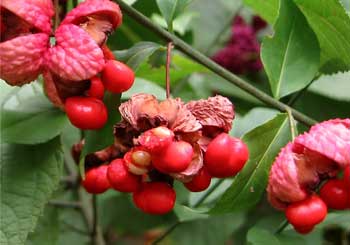Contents:
Common Names | Parts Usually Used | Plant(s) & Culture | Where Found
Uses | Warning | Bibliography
Scientific Names

- Euonymus americanus L.
- E. American euonymus
- Staff-tree family
Common Names
- Strawberry
Parts Usually Used
Stem and root bark, seeds
Back to Top
Description of Plant(s) and Culture
This herb is not the garden strawberry. It is a bush 3-6 ft tall with flowers that are greenish-purple. Erect or straggling, deciduous or nearly evergreen shrub. Stalks are green, 4-angled. Leaves rather thick, lustrous, sessile; tips sharp-pointed. Flowers greenish purple; petals stalked. Flowers in May to June. Fruits scarlet, warty. Do not look like garden strawberry fruit.
Strawberry bush (Euonymus americanus) is a related plant to wahoo (Euonymus atropurpureus). Medicinally strawberry bush is equivalent to wahoo.
Back to Top
Where Found
Rich woods. Southeastern New York, Pennsylvania to Florida; Texas, Oklahoma to Illinois.
Back to Top
Uses
Native Americans used root tea for uterine prolapse, vomiting of blood, stomachaches, painful urination, wash for swellings. Bark formerly used by physicians as tonic, laxative, diuretic, and expectorant. Tea used for malaria, indigestion, liver congestion, constipation, lung afflictions. Powdered bark applied to the scalp was thought to eliminate dandruff. Seeds are strongly laxative.
Back to Top
Warning
Fruit, seeds, and bark may be poisonous. Do not ingest. Fruits may cause vomiting, diarrhea, and unconsciousness.
Do not use without medical supervision.
Back to Top
Bibliography
![]() The Herb Book
The Herb Book, by John Lust, Bantam Books, 666 Fifth Avenue, New York, NY. copyright 1974.
![]() Eastern/Central Medicinal Plants
Eastern/Central Medicinal Plants, by Steven Foster and James A. Duke., Houghton Mifflin Company, 215 Park Avenue South, New York, NY 10000
 The Rodale Herb Book: How to Use, Grow, and Buy Nature’s Miracle Plants (An Organic gardening and farming book)
The Rodale Herb Book: How to Use, Grow, and Buy Nature’s Miracle Plants (An Organic gardening and farming book), edited by William H. Hylton, Rodale Press, Inc. Emmaus, PA, 18049., 1974
![]() Webster’s New World Dictionary
Webster’s New World Dictionary, Third College Edition, Victoria Neufeldt, Editor in Chief, New World Dictionaries: A Division of Simon & Schuster, Inc., 15 Columbus Circle, New York, NY 10023
